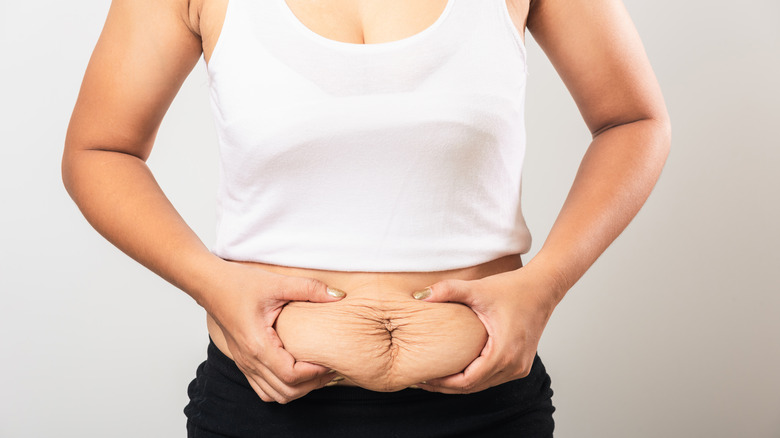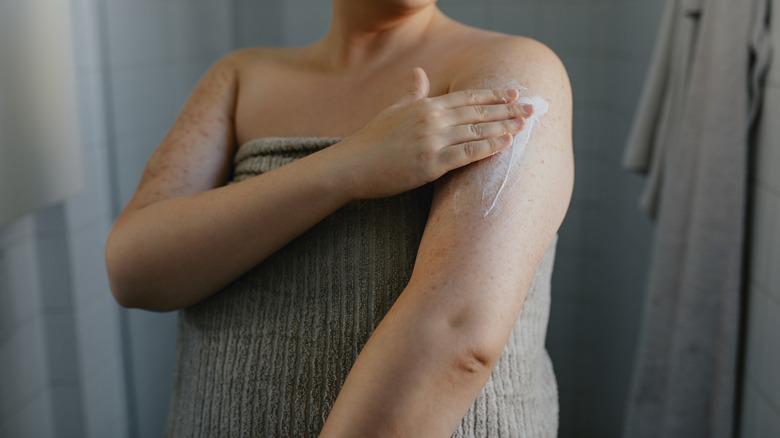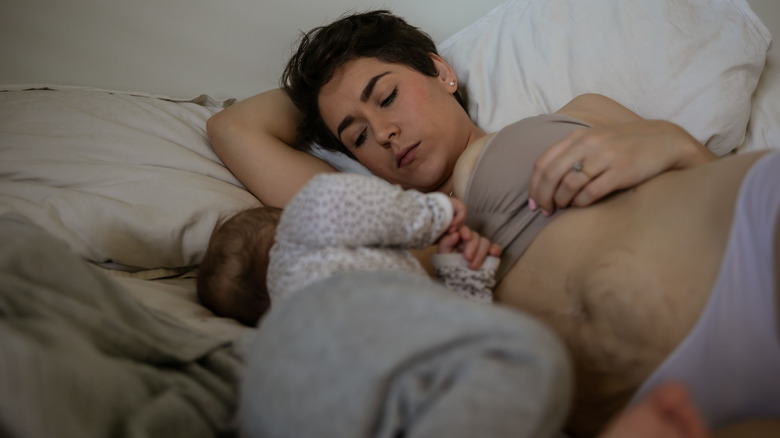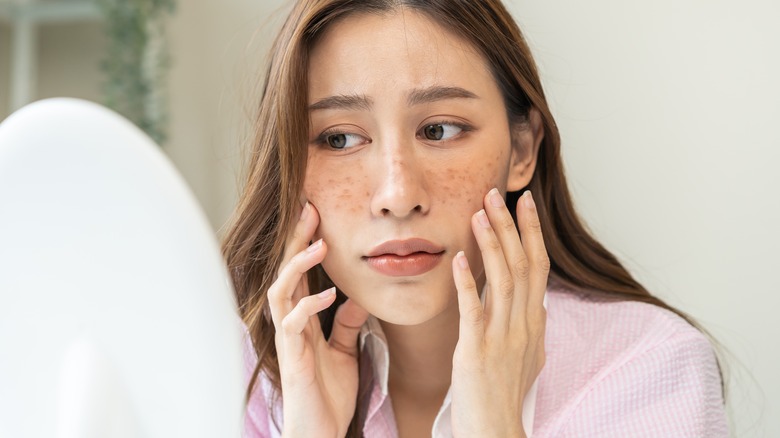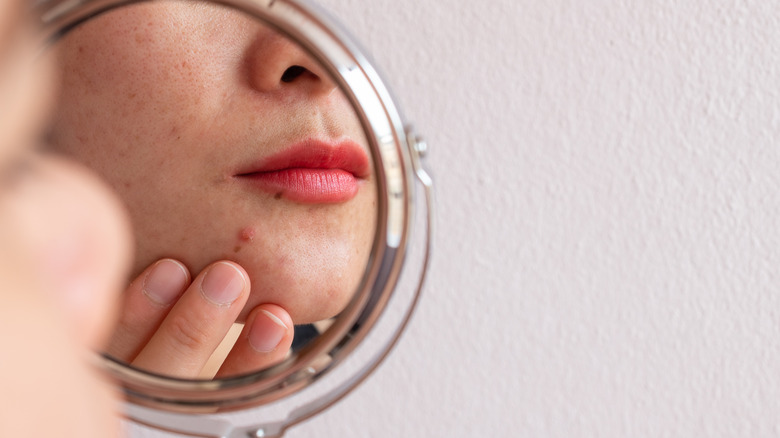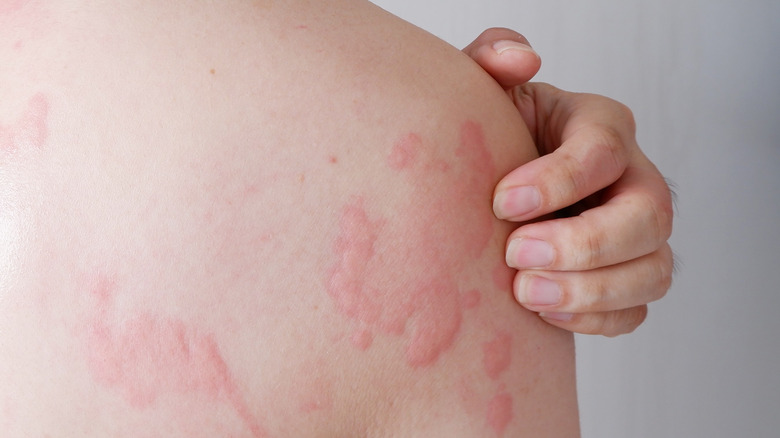Tackling Postpartum Skincare, Because Of Course That Changes
"You're glowing!" might just be the most highly coveted compliment a pregnant woman can receive. Though once attributed to the joy one feels from pregnancy, it turns out the experience isn't an old wives' tale. Luminous skin is often regarded as one of the surprisingly positive side effects of pregnancy. Commonly referred to as 'pregnancy glow' it's believed to be caused by an increase in blood volume and circulation spurred by nourishing a fetus.
But while expectant mothers can bask in the glory of their iridescent skin with the 'pregnancy glow', postpartum mothers often face the opposite plight. According to the Journal of Medicine and Primary Care, an estimated 90% of mothers experience unwanted changes to their skin post-delivery. The most commonly reported postpartum skin issues are loose skin, dry skin, stretch marks, melasma (or hyperpigmentation), breakouts and acne, and newly developed skin sensitivities.
After having a baby, priorities change for most women. Sleepless nights, an extra body to feed, running between appointments — how is it possible for moms to come up with a skincare routine themselves? While it isn't always possible to reverse skin changes brought on by pregnancy, here are some mom- and baby-safe ways that can mitigate them.
Collagen helps firm up loose skin
To make space for its growing baby, the pregnant body releases a hormone called relaxin. As the name suggests, this hormone relaxes muscle ligaments in the womb. Dr. Mark Doyle from the Gold Coast Plastic Surgery Clinic explains that as these muscles stretch, they force the skin around them to expand too.
Normally, if you pulled your skin and let go, it would return to place. This is due to skin elasticity (like an elastic band that bounces back after being tugged on and released). However, with prolonged stretching, the skin struggles to maintain its structure. When the baby that was causing it to stretch is no longer present, the skin hangs loose instead of returning to its original form. Collagen is a body protein that has been linked to maintaining structure and encouraging elasticity, but research shows collagen stores reduce drastically following delivery. Conversely, supplementing collagen can treat loose skin, according to a 2021 review.
Massaging increases blood circulation which helps skin appear firmer. You can also look for a firming cream rich incollagen and elastin, another protein known for supportingligament elasticity.
Implement the moisturizer trifecta to combat dry skin
Following delivery, the pregnancy hormones estrogen and progesterone drop drastically, causing dry skin and other issues. Dermatology Times points out this may be accentuated for breastfeeding mothers since milk production demands water. If these water levels are not adequately replenished, skin is likely to appear dry. The right moisturizer can help combat this. Dr. Nikoleta Brankov asserts that an effective moisturizer should contain three parts: humectants, occlusives, and emollients.
Humectants bring water from your surroundings toward the skin. Popular humectants are hyaluronic acid and glycerin. A humectant will draw hydration toward your body, but an occlusive will trap the hydration in place. Occlusives can come in the forms of jellies (think petroleum jelly) or plant and mineral oils. By trapping water on your skin, occlusives prevent water loss and make hydration last longer. Lastly, emollients improve skin texture by smoothing out dry patches – exactly what is needed for moms experiencing excessive dry, flaky patches or eczema. Dr. Brankov highly recommends ceramides as a type of emollient.
Glycolic acid can reduce the appearance of stretch marks
Stria gravidarum are the type of stretch marks postpartum women experience. They are caused by mechanical stretching and relaxing of skin, changes to structural proteins like collagen, and hormonal changes from pregnancy to post-delivery. One 2017 review shows that topically applying tretinoin and glycolic acid can diminish stretch mark appearance. However, breastfeeding mothers should avoid tretinoin. Instead, glycolic acid-based products are your holy grail until breastfeeding is stopped.
We already know collagen promotes firmness by maintaining structure and promoting elasticity. By the same mechanism, it maintains skin color and tone. Glycolic acid reduces the appearance of stretch marks by helping form collagen and a type of cell called a fibroblast, which connect muscles healthily. Replenix offers glycolic acid creams available in concentrations from 10-20% so that you can find the one most suitable for you.
When stretch marks first form, they appear red or purple. These are easier to treat because they are young. White stretch marks, on the other hand, are scar tissue from older stretch marks and much more difficult to erase.
UV antagonists can lighten melasma and hyperpigmentation
During pregnancy, some women find hyperpigmented (or darker) patches of brown to gray-brown skin on their face and bodies, known as melasma. This is due to an increase in a chemical called melanocyte-stimulating hormone, which is responsible for creating melanin. The more of this hormone you have, the darker your skin appears, contributing to hyperpigmentation. For some mothers, the surge in this melanin stimulating hormone doesn't drop after delivery, even after other pregnancy hormones drop.
Vitamin C, or ascorbic acid, can reduce the visible effects of melanin by stopping its production. Vitamin C is a UV antagonist, which means it blocks the process by which UV radiation changes cellular appearance. Sunscreen can also help to reduce melasma, or prevent the skin from darkening further, by blocking more UV light from damaging the skin's cells.
Although they are highly effective, mothers should be cautious of using UV antagonists like hydroquinone and retinoids according to Dr. Shereen Idriss. Instead opt for kojic acid and azelaic acid, which are known to be gentler.
Cleanse pores with topical acids to treat breakouts and acne
As hormones re-adjust after delivery, some mothers experience excess sebum and oil production. This can trap dirt and dead skin inside pores causing breakouts. In addition, increased stress and lack of time for an effective skincare routine can contribute to breakouts as well. Topical application of acids like benzoyl peroxide, azealeic acid, and salicylic acid haven been shown to be safe methods for de-clog pores. Retinoids often come highly recommended as acne treatments, but breastfeeding moms should avoid them as they can pass to the baby. Mothers should also beware of applying topical treatments to their chest for acne or breakouts in this area to soon before breastfeeding. It is best to wait 30 minutes (or as long as your physician states) before feeding.
Antihistamines can help cope with newly sensitive skin
Some mothers find that their skin has developed new sensitivities after delivery, or maintained sensitivities that were brought on during pregnancy. Research estimates one in 130 to 300 of new mothers face PEP (polymorphic eruption of pregnancy) or PUPPP (pruritic urticarial papules and plaques of pregnancy), which are more commonly known as hives. Some doctors hypothesize that pregnancy may trigger sensitivities that lead to PEP because of all the stretching of the skin and damage the connective tissue endures during the third trimester, when moms are at their largest. Hives typically present on areas that are most prone to changes, like thighs, abdomen, and buttocks. Alternatively, breastfeeding may trigger the development of hives. Prolactin is the hormone that stimulates milk production, which some mothers may be sensitive to.
Though PEP and PUPP are often harmless, the itching and appearance they bring is very frustrating. Doctors recommend antihistamines in combination with cold baths to reduce the swelling and itchy symptoms. If these don't work, talk to your doctor about getting a steroid prescription. As a rule of thumb, opt for wearing loose cotton or linen to avoid irritating the skin further.
Multi-use products can simplify a postpartum skincare routine
Making a skincare routine while caring for a baby can be burdensome. But many postpartum skin conditions are interrelated, so their treatments can be too. For example, vitamin C brightens skin, reducing hyperpigmentation, but it also promotes collagen. Collagen can simultaneously firm skin and reduce stretch marks by repairing muscle structure. Sunscreen, meanwhile, can protect against skin sensitivities and unwanted darkening from UV radiation. When your capacity is low, it's impossible to curate a 12-step Korean skincare routine, but if a single product can combat multiple conditions, you can whittle down your routine to just the essential steps.
At nighttime, start again with a cleanser, to remove buildup from dirt, pollution, and oil. Next, apply acids, creams, or treatments based on your particular desires.You can layer, but it's best to avoid combining products that work against each other as per the product's instructions, which will also save time.
Postpartum skincare is all about nourishing the body
Many moms always have their babies on their mind, and their postpartum body is just another reminder of the changes they have gone through. Most of us have a facial skincare routine, but new moms know that their body skin needs love too. Every step in your routine is applicable to your body in the same order but always complete your facial skincare first, wash your hands, and then go through the motions for your body products. Your body's skin is more hardy than your face's so these products may clog your facial pores.
While topical treatments like serums, gels, and creams can help you approach desired results, authentic skincare starts from within. It's easier said than done, but prioritizing adequate sleep, nutrition and exercise (just as you prioritize them for your baby) is the best foundation for a solid postpartum skincare routine. These pillars work together in combination with your cosmetic regimen to replenish and maintain nourished skin after delivery.

